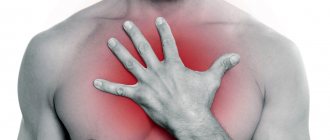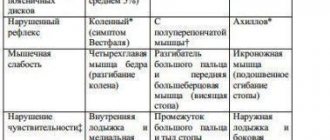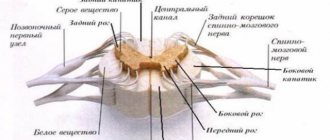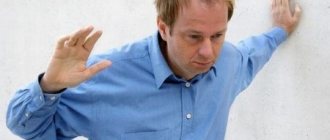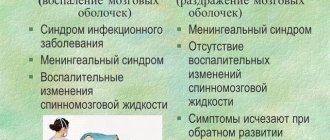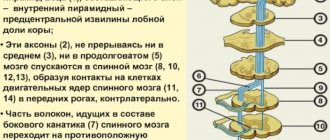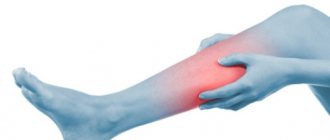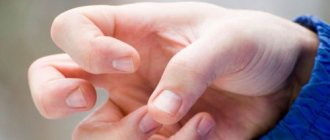Meningitis #3
This post is for informational purposes only.
There are no stories in it. I continue to talk about meningitis. Depending on the etiology, that is, on the causes that provoked meningitis, this disease can be infectious, infectious-allergic, microbial, neuroviral, traumatic or fungal.
Microbial meningitis, in turn, can manifest itself in the form of serous meningitis, tuberculous meningitis, influenza or herpetic meningitis. Accordingly, the clinical manifestations will be different. Of course, there are also common signs - the so-called meningeal signs.
We will talk about them today. In the future, when describing any type of meningitis, I will refer to this post.
The topic of today’s post is “Meningeal signs (symptoms)”
.
Koernig's sign
. It consists of the inability to straighten the patient’s leg at the knee joint when it is bent at the hip. It is not pain that interferes with extension, but tension in the posterior thigh muscles (tonic sheath reflex). It is one of the most common and persistent symptoms of meningitis.
It's done like this
:
A person lying on his back is forced to bend one leg at the hip and knee. With meningitis, it is impossible to straighten the leg back at the knee due to severe muscle tension. This symptom manifests itself at the initial stage of inflammation of the meninges, which allows timely detection of the presence of pathology.
It should be remembered that in children such meningeal signs may not appear at all. In infants up to 6-8 weeks and in children suffering from Parkinson's disease or myotonia, Kernig's sign is a consequence of excessively high muscle tone and may not be a sign of meningitis.
Upper Brudzinski's sign
- when the patient's head is passively brought to the sternum, in a supine position, his legs bend at the knee and hip joints.
It goes like this:
The person’s head is tilted forward, while the patient’s legs will involuntarily be pulled towards the stomach.
Average Brudzinski's symptom
- the same bending of the legs when pressing on the pubic symphysis.
It goes like this:
Gently press on the pubic area. The patient's legs will involuntarily be pulled towards the stomach.
Lower Brudzinski's sign
- when one leg of the patient is passively flexed at the knee and hip joints, the other leg is bent in a similar way.
It goes like this:
A person lying on his back is forced to bend one leg at the hip and knee.
In a patient with meningitis, the second leg will also bend reflexively.
Subzygomatic (cheek) Brudzinski's sign
— when pressing on the patient’s cheeks directly under the cheekbones, a reflex raising of the shoulders and flexion of the forearms occurs (due to the peculiar posture, this symptom is also called the “cross” symptom)
Guillain's sign
- compression of the patient’s four thigh muscles on one side causes involuntary flexion in the hip and knee joints of the opposite leg.
Hermann's sign
- (
symptom “neck - big toe”
) - with passive flexion of the neck, the patient experiences extension of the big toes; the symptom was described by the Polish neurologist Euthymius Herman for tuberculous meningoencephalitis.
Lessage's "suspension" symptom
.
A newborn baby is taken by the armpits with both hands, holding the head from the back with the index fingers, and raised, which leads to an involuntary pulling of the legs towards the stomach due to bending them at the hip and knee joints and prolonged
fixing them in this bent position. In a healthy child, during the Lessage test, the legs move freely (bend and unbend).
Mondonesi's sign
- pressing on the eyeballs through closed eyelids is painful.
Rigidity of the muscles of the back of the head and neck.
In a patient with meningitis, the muscle group in this area is so tense that an attempt to bend the head forward and pull the chin to the chest remains unsuccessful. This symptom is not taken into account if the patient has problems with the spinal system that limit movement.
Mendel's symptom
. The already intense pain in the head intensifies when pressing with a finger on the ear in the area of the external auditory canal.
Bekhterev's symptom.
Tapping your cheekbone with your fingers provokes contraction of the facial muscles and the appearance of a grimace due to the resulting pain from the impact.
Flatau's symptom.
The patient's pupils dilate when the head is forced forward.
Babinski's sign.
The first toe straightens and protrudes to the side under the influence of a sharp object on the outer edge of the foot.
It goes like this:
The doctor moves the handle of the hammer along the outer edge of the foot, bending the trajectory into an arc under the toes. The procedure should be easy and not cause pain. With a positive Babinski sign, a fan-shaped extension of the toes occurs in response to irritation. Normally, the plantar reflex occurs, which manifests itself in the involuntary flexion of the big toe.
Pointing dog position
. The patient presses his legs to his stomach, while his spine involuntarily arches in a supine position and his head throws back.
Fanconi's sign
. A person is not able to sit up independently if he is in a lying position (with his knees bent or fixed).
PS That's all for today. For those who think that my posts with the tag #information are incorrect and uninformative, I suggest you write an informational post yourself and call me so that I can learn from those who know and can. I'll read it with pleasure.
Source: //pikabu.ru/story/meningit_3_5853577
Animation 3
Read:- ACTIVITY #12
- To qualify for a practical lesson, you must bring the following.
- CLASS
- Class
- Class
- Class
- Lesson 12 - Reservoirs, their purpose and classification
- Lesson 12.
- LESSON 13 (repetition)
Lesson topic: Sensitive sphere
Purpose of the lesson: to master the methodology for studying sensitivity; know : the course of conductors of temperature and pain sensitivity, deep muscle-articular sensitivity: be able to identify various types of sensitivity disorders; investigate symptoms of sciatic and femoral nerve tension; meningeal symptoms; have an idea of sensory disorders at various levels of damage to the nervous system.
Homework on the topic: “Sensitive Sphere.”
1. Types of sensitivity.
2. The course of conductors of temperature and pain sensitivity (draw a diagram in the outline).
3. The course of conductors of deep muscular-articular sensitivity (draw a diagram in the outline).
4. Methods for studying superficial and deep sensitivity, symptoms of tension of the sciatic and femoral nerves, meningeal symptoms. In the summary, describe the methodology for studying the symptoms of Lasegue, Wasserman, Neri tension, meningeal signs (stiff neck, Kernig's, Brudzinski's symptoms). Know the differences between tension symptoms and meningeal signs.
5. Types of sensitivity disorders. In the summary, indicate the location of the lesion and describe mononeuritic, polyneuritic, radicular, segmental, conduction types of sensory impairment, hemianesthesia, focal somatosensory epileptic seizures.
PLAN FOR STUDENTS' INDEPENDENT WORK WITH PATIENTS.
1. Take anamnesis
2. Find out the presence of pain, determine its nature:
· local pain – pain at the site of injury, associated with damage to pain receptors (nociceptors);
· projection pain – pain in the innervation zone;
· radiating - along the course of a root or nerve (cervical radicular pain is localized in the cervical spine, radiating along the length of the arm; lumbosacral radicular pain is localized in the lower back, radiating along the length of the leg; thoracic radicular pain is of a girdling nature);
· causalgia: burning, excruciating pain, which occurs more often when the median or sciatic nerve is damaged;
· phantom pain : occurs after amputation of a limb, localized in the missing part of the arm or leg;
· referred pain : when internal organs are damaged in the Zakharyin-Ged zones.
3. Check the symptoms of tension in the roots and nerve trunks:
- Lasègue symptom : in a patient lying on his back, the straight leg rises or the leg, previously bent at the hip and knee joints, extends at the knee joint; with a positive symptom, pain appears in the lower back and along the back of the leg.
- Wasserman's symptom : in a patient lying on his stomach, the straight leg rises, pain appears along the front surface of the thigh,
- Neri's sign : the patient lying on his back bends over
head, pain appears in the area of the affected roots.
4. Check meningeal symptoms:
= rigidity of the muscles of the back of the head: it is impossible to bend the head (to touch the chest with the chin) to a patient lying with straight legs on his back;
= Kernig's symptom : difficulty due to muscle rigidity when extending the knee joint of a leg bent at the hip and knee joints;
= upper Brudzinski symptom : flexion of the knee joints of the legs in a patient lying on his back when bending the head;
= lower Brudzinski's symptom : flexion of the knee joint of the leg of a patient lying on his back while causing Kernig's symptom on the other side;
= “suspension” (Lesage) symptom in a child of the first year of life: flexion contracture of the legs in a child lifted by the armpits.
5. Examine sensitivity:
pain sensitivity is examined using a needle; injections are applied with equal force symmetrically on both sides in the following sequence: scalp, shoulder girdle, upper arm, forearm, hand from the thumb and from the little finger, along the nipple line, torso (from top to bottom), front surface of the leg (outer and inner surface) , back of the leg (outer and inner surface), buttocks from the outer parts to the anus;
temperature sensitivity is examined in the same sequence using test tubes with hot and cold water;
deep muscular-articular sensitivity is checked on the hands and feet (small movements in the terminal phalanges of the fingers) with eyes closed: the patient determines the direction of movement of the finger; on the torso, deep sensitivity is determined by the displacement of the skin fold: the patient indicates the direction of movement of the skin fold;
stereognosis - the ability to recognize an object by touch is determined.
6. Identify the type and type of sensory impairment present in the patient.
Note!
Date added: 2015-10-11 | Views: 244 | Copyright infringement
1
What are the meningeal symptoms and how to recognize them?
Brain diseases are characterized by the presence of specific symptoms, the basis of which is meningeal symptoms. These symptoms are the main evidence of the onset of serious changes in the nervous system, and the sooner the disease is recognized and treatment is started, the greater the chance of recovery without serious consequences.
The main thing is not to make mistakes...
It is no coincidence that meningeal signs have this name, since in the vast majority of cases the cause of their manifestation is meningitis. Its different forms are characterized by certain symptoms, but the basis is meningeal.
With meningitis, in addition to inflammatory processes in the brain, noticeable changes occur in the cerebrospinal fluid, and this is one of the features of the course of the disease.
There are a number of causes that can cause symptoms similar to meningeal syndromes, but do not affect the spinal cord, in particular:
- excessive sunbathing
- excessive saturation of the human body with water (usually occurs after severe dehydration)
- severe infectious diseases (salmonellosis, typhoid, influenza)
- alcohol poisoning
- transient cerebrovascular accident (TCI)
- allergies
- brain tumors
- radioactive damage to the body
All of the above can cause the development of meningeal syndrome, but in this situation the treatment differs from the treatment of meningitis.
In addition, there is such a thing as “pseudomeningeal symptoms,” which occur in some diseases that are not associated with damage to the meninges (mental disorders, osteochondrosis). That is why it is important to take into account all manifestations and make the correct diagnosis.
Classification
It's time to look directly at the symptoms themselves, which are commonly called meningeal. The meningeal symptom complex includes:
a – pointing dog pose, b – Kernig’s sign, c – Brudzinski’s sign
- Kernig's sign
- Brudzinski syndrome
- headache
- vomit
- Bekhterev's symptom
- Gordon's reflex
- Guillain's reflex
- Le Sage syndrome
- stiff neck muscles
- presence of a “pointing dog” pose
- hyperesthesia
Kernig's sign
To diagnose a syndrome such as Kernig's symptom, the patient is asked to take a supine position, after which the doctor bends his leg at the hip and knee joints at an angle of 90°. Flexion occurs unhindered, but problems arise with extension. So, due to tension in the muscles of the back of the thigh, the patient cannot do this on his own.
Brudzinski syndrome
Brudzinski meningeal syndrome has several variations, including:
- Buccal.
- Lower.
- Upper.
- Average.
Buccal – the doctor applies pressure to the patient’s cheek, resulting in involuntary flexion of the arms at the elbow joint, as well as a kind of shrug of the shoulders.
Lower - With the patient sitting, one of the legs is bent, the second automatically bends along with the first.
Upper – the patient’s head is tilted forward, and the legs are automatically bent.
Medium – when pressing on the patient’s pubis, the legs bend.
Often, Kernig and Brudzinski syndromes occur together in meningitis.
Headache
When meningitis occurs, headache accompanies the patient constantly and does not stop for a minute. It is one of the most pronounced meningeal symptoms.
Vomit
Gag reflexes can occur in a patient even in the absence of such manifestations as primary symptoms, such as nausea. Vomiting occurs suddenly against the background of a severe headache and is characterized by a gushing outpouring.
In some cases, there is a decrease in the intensity of headaches after bouts of vomiting.
Bechterew's syndrome
Meningeal ankylosing spondylitis is diagnosed by tapping the patient's cheekbone with a finger. This tapping causes a severe headache on the side of the face where there is inflammation, in addition, this side will curl up in a grimace of pain.
Gordon reflex
Gordon's meningeal syndrome is diagnosed by a neurologist as follows: the doctor wraps his hand around the patient's lower leg and applies strong compression. As a result, the patient's big toe unclenches, and the fingers also diverge in different directions.
Guillain reflex
The patient is asked to take a lying position, after which the doctor applies pressure on the front surface of the thigh of one of the legs or squeezes it. As a result, the opposite leg involuntarily bends at the knee.
Lesage syndrome
This symptom is typical for infants, and in most cases it is diagnosed in them. The patient lifts himself by the armpits above the floor, as a result of which the baby's legs involuntarily tighten (are pulled towards the chest).
Neck muscle stiffness
This condition is characterized by hypertonicity of the occipital and cervical muscles and manifests itself in the inability or difficulty in performing simple actions, such as turning the head or tilting it.
Often, muscle rigidity is characteristic of young children, but not as a symptom of meningitis, but due to the fact that the peripheral nervous system is not fully formed. Therefore, it is extremely important to diagnose the disease comprehensively and be based on several factors.
Pointing dog pose
In some sources there is such a name as the “cocked hammer” pose. It manifests itself as follows: the patient throws his head back, the torso is tense and elongated, the arms are pressed tightly to the chest, the legs are also pulled up to the thoracic region.
Hyperesthesia
Meningeal hyperesthesia syndrome, or increased light and noise sensitivity, manifests itself in the form of painful perception by the patient of bright light and loud sounds. For this reason, the patient is recommended to stay in a darkened room and, if possible, completely eliminate irritating sounds.
Features of the course of the disease in children
As for children, at an early age it is difficult to diagnose the disease based on meningeal symptoms, since most of them do not appear.
The main symptom characteristic of children is Le Sage syndrome, as well as a severe headache, against the background of which the child becomes irritable, refuses to eat and develops apathy.
Rare species
Modern neurology, in addition to the above, there are other meningeal syndromes, however, their manifestations are rare, these include:
- Levinson's sign (opening of the mouth when trying to touch the chin to the chest).
- Perrault's sign (pupil dilation with any pain).
- Mendel's sign (pressure on the eyeballs or ears causes pain).
Thus, as soon as meningeal syndrome manifests itself in a patient, the patient must immediately take measures to contact a specialist and begin treatment as soon as possible, since in addition to mild forms of meningitis, there is a possibility of developing acute forms of meningitis, which can be fatal.
Source: //nervivporyadke.ru
Source: //zen.yandex.ru/media/id/595f61ded7d0a69b431e48f9/5dac54d46f5f6f00ae7b68e8
